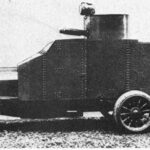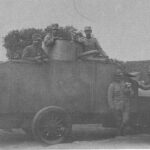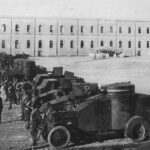The Fiat Arsenale model is here
History:
The Fiat Arsenale, also called A.MICO (AutoMitragliatrice Corazzata), was the first Italian armored vehicle built and used in combat and its design will influence all other Italian armored cars until 1932. Based on a project issued by the General Staff at the end of June 1912, it was built by the artillery arsenal of Turin, commanded by colonel bonagente aided by captain lualdi. As usual at that time, they took a truck chassis, in this case, the Fiat 15 bis (4X2) also known as tipo Libia and equipped it with their own armor body. Many other armored cars of the time were built according to a similar scheme. The main reasons for this were lack of experience in the design and construction of armored vehicles, limited industry capabilities, etc. However, this approach also save time on its construction. The place of its conception gave also its name: Fiat Arsenale. The base chassis, borrowed from a FIAT 15 bis truck, was equipped with two axles with leaf springs. In front of the chassis were a 4 cyl. gasoline engine and gearbox. Torque transmitted only to the rear axle. The front steering axle was equipped with single wheels, at the rear, double. According to reports, the authors of the project decided not to abandon the existing pneumatic tires but to facilitate driving on sand, the wheels were equiped with articulated rims of the type used for the 75A gun In other projects of armored cars of that time, tubeless tires were used that were resistant to damage, but the engineers of the Turin Artillery Arsenal decided to use the existing wheels without any changes. The FIAT Arsenale Mod.1912 (as it was also called), received an armored body, divided into the motor and combat compartments. The hull was made of 3 mm armor plates riveted on a frame structure. The engine hood was made of several armor plates. It consisted of two vertical sides and a curved top cover. Instead of a front armor plate for the engine compartment, a lattice panel was installed on the car, which completely covered the front part of the bonnet and ensured optimal engine cooling. No special access hatches were provided for the engine. For maintenance, the crew had to unscrew the bolts and remove the plates of the hood. The combat compartment was made of several straight armor plates also riveted on a frame. The sides of the hull were arranged vertically. The partly opened horizontal roof had a small bevel aft. Thus, in its design FIAT Arsenale Mod.1912 was a typical armored car of its time. The upper frontal part of the combat compartment had a hinged hatch cover. Outside the battlefield, the driver could follow the road through a wide access hatch. To the left of the driver there was a large door for boarding in the car. A cylindrical open topped tower with a rectangular frontal part was located on the roof of the armored car. The crew of the car consisted of three soldiers: the driver, the commander and the gunner. The driver was located in front of the combat compartment, the commander was next to him. The gunner was to be in the tower to control the weapon. Due to the lack of experience in the construction and operation of armored vehicles, the specialists of the Turin Arsenal equipped their car with only one 6,5 mm Maxim machine gun with water-cooled barrel. On one of the surviving photos, you can see the searchlight mounted on the turret above the machine gun. The use of the serial chassis and its limited capabilities led to the fact that the combat weight of the new armored car did not exceed 3 t. The relatively low-powered engine did not allow showing high running characteristics: the speed on road did not exceed 25-30 km / h. Range was between 100 and 200 km.
Combat use:
The two assembled FIAT Arsenale armored cars went through small factory tests, after which they were accepted by the army. During this time, the war in Libia with Turkey moved to a positional war and the situation on the long front was constantly becoming more complicated. It required a new tool that could reverse the course of the fighting. This means, as the military considered, new armored cars. The two cars leaved Italy on September 4, 1912 for Zuara in Libya. The two cars had some minor differences. On October 2, one of the two was part of the 5th Division in Misrata to escort the automobile columns. The military history is very short because the peace was signed on October 12, 1912. Between 1913 and 1915, the two cars went under heavy modifications, A new non riveted body with a new front plate with new vision hatches was added as side vision slots and a new more inclined turret. The Fiat Arsenale remained in service at least until 1922 because there is a photographic evidence that shows the modified version dated from 1922. They were renamed Fiat tipo Libia not be confused with Fiat Terni/Tripoli. This is why reference is sometimes made to 14 Fiat Terni/Tripoli produced (in 1931 renammed libia).







